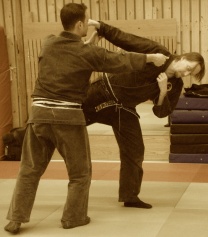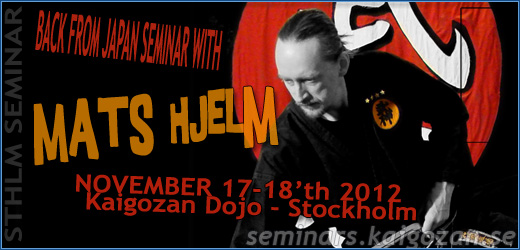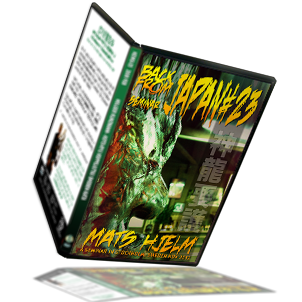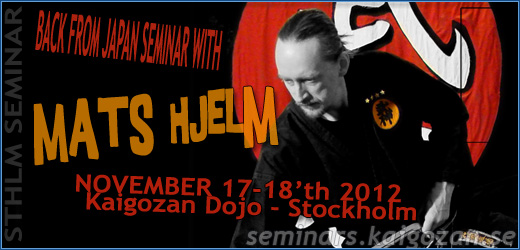From The Magick & The Mundane » Bujinkan by Shawn Gray
I was asked today to write something about Kaname in advance of a seminar I’ll be giving at Bujinkan Manitoba on May 26/27. The following are some thoughts I put down based on my experience of feeling and hearing what Sensei has been teaching on this subject this year.
Kaname (要) is a word that means “essence,” or “essential point.” It refers to that which is necessary for a thing to be what it is. For example, each technique from our Nine Schools has something about it that makes it unique. For Ganseki Nage to be Ganseki Nage, and not Omote Gyaku, there are things about it that make it distinct. Those things are the “Kaname” of Ganseki Nage, the things that make it what it is, distinct from other techniques, the things that comprise its essential character.
 Hatsumi Sensei used to talk a lot about Kyusho. Early on, he talked about how important it was to know the Kyusho points, and about how important it is to practice hitting them accurately and effectively. People were taught the names of fixed Kyusho points found in various Ryu Ha, and diagrams of the locations of these points on the body appeared in books. Later, Hatsumi Sensei emphasized that it is important not only to know where the fixed Kyusho are, but to realize that other people also know where they are, so they can be protected or used against you. Being fixed in place, they become common knowledge, something that is easily referenced by anyone with an interest in the human body. Later on, Sensei would emphasize that it’s important to be able to create your own Kyusho at will, rather than being tied into a fixed idea that a Kyusho is a fixed location on the body. The idea of Kyusho became more to do with taking advantage of openings that the opponent gives you, or that you create, regardless of whether or not the openings happen to coincide with a set “pressure point.”
Hatsumi Sensei used to talk a lot about Kyusho. Early on, he talked about how important it was to know the Kyusho points, and about how important it is to practice hitting them accurately and effectively. People were taught the names of fixed Kyusho points found in various Ryu Ha, and diagrams of the locations of these points on the body appeared in books. Later, Hatsumi Sensei emphasized that it is important not only to know where the fixed Kyusho are, but to realize that other people also know where they are, so they can be protected or used against you. Being fixed in place, they become common knowledge, something that is easily referenced by anyone with an interest in the human body. Later on, Sensei would emphasize that it’s important to be able to create your own Kyusho at will, rather than being tied into a fixed idea that a Kyusho is a fixed location on the body. The idea of Kyusho became more to do with taking advantage of openings that the opponent gives you, or that you create, regardless of whether or not the openings happen to coincide with a set “pressure point.”
Now we are talking about Kaname, and in this I think Sensei is taking the Kyusho idea one step further to apply to any factor in any situation rather than any point (fixed or not) on the body. So not only are there Kyusho on fixed points on the body, and not only can new ones be created on an as-needed basis, but any of the factors in a given situation, in a given moment, can be used to create the optimal outcome. In Budo techniques, these factors generally fall into what I call the Kihon No Goshin (基本の五心) – the 5 Essential Basics: Distance, Timing, Angling, Balance, and Force.
When working through a technique, at any given moment in that process, there is a key essential factor (which is likely one of the Kihon No Goshin, or a combination of two or more – but it could also be something else, like the placement of an elbow, or that a hand is in a certain position at a certain point in order to guard against a potential attack at that point) that must be employed in order to produce the optimal result. The more this does not happen, the less efficient and the less effective things become. It’s the same thing in life.
Shiraishi Sensei often says, “Constantly ask yourself, ‘What is the most important thing that I could be doing right now?‘” At any given moment in our lives, there is Something that we could be doing that is most in line with who we are and what we need to be doing at this moment (both at this moment in time and at this time in our lives) in order to accomplish that which we are here to do. That Something is the Kaname of that moment, and the less often we do that Something each moment, the further away we grow from being Who we are meant to be. In Taijutsu, the Kaname is the essential point that makes a movement work, its functional essence, and in life, the Kaname is the Essence of Who-You-Are – your true inner self, your ultimate identity.
In Taijutsu, the Kaname is dynamic, always changing, always flowing from one point to the next. It is not optimal to do the same Something each moment. It is not optimal that every technique be the same. It is important to be able to constantly adapt with the Kaname, to be able to recognize it when it appears, and follow it where it goes. In everyday Japanese, the word “Kaname” is often used with 2 other characters to read, “Kanjin Kaname” (肝心要), “the essential point.” When the characters are changed to 神心神眼 (normally read as “Shinshin Shingan”), they can also be pronounced “Kanjin Kaname,” but with the meaning of, “divine mind, divine eyes.” In other words, divine mind and insight reveal what the Essence is.
In training this year, we are looking at ways of recognizing the Kaname in Budo, at ways of seeing where it is going, and at ways of learning how to learn to ride with it as it constantly flows and changes. Taking the lesson beyond the walls of the dojo, there is always Something optimal that we can be doing to grow and evolve with the changes that Life presents us, the essential point of every moment.
Shikin Haramitsu Daikomyo – May each moment bring you Great Light!


…

 - New DVD from BUDOSHOP.SE – Click HERE to order! (74 min)
- New DVD from BUDOSHOP.SE – Click HERE to order! (74 min)

